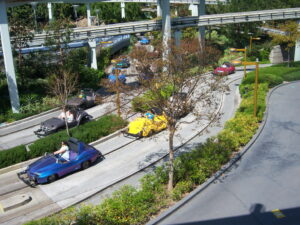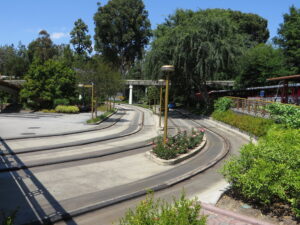
Autopia, a miniature motorway attraction in Tomorrowland at Disneyland, has decided to remove its gas-engined cars. Designed by Bob Gurr in 1955, the attraction was inspired by the invention of “freeways” at the time. The public’s fascination with transportation changes fueled this ride’s popularity. With the prevalence of climate change and the negative environmental impact of greenhouse gas emissions through pollution, Disney is taking steps toward becoming a more conscientious amusement park.
The upgrades in Autopia are just the beginning of changes being brought to Disneyland in an effort to become more sustainable. Removing gas cars would be the first step toward the Disneyland Resort’s ultimate goal of net-zero carbon emissions by 2030. According to the Environmental Protection Agency (EPA), a typical vehicle emits 4.6 metric tons of just carbon dioxide annually. Mixing in gasoline-produced methane and nitrous oxide, the continuous use of Autopia’s cars for the past few decades amounts to a high level of greenhouse gas emissions. Disney’s commitment to environmental sustainability is a demonstration of the changes necessary to tackle this eminent global threat.
Climate change activists Zan Dubin and Paul Scott have noted Disney’s negative environmental impact in the past. They filed two case investigations with the California Air Resources Board for air quality testing. Despite complaints, officials’ hands were tied for regulations as the amusement park is private property, and visitors can easily take the necessary precautions not to go near certain rides. Moreover, attraction-goers also complained about Autopia and the distinct gas smell that permeates the surrounding air. Some attributed the stink to exhaust and fuel.

In its initial efforts to offset carbon emissions, Disney spent over $15.5 million in carbon offsetting schemes related to deforestation and reducing industrial gases. While the company claims the use of verified offsetting projects, most of them are not directly eliminating greenhouse gas emissions to combat Disney’s pollution. Several companies have turned to offsetting projects as a way to continue unsustainable business operations without facing consequences. However, Disney’s position on sustainability seems to have changed.
The resort’s Spokesperson, Jessica Good, spoke on Disneyland’s intentions to use alternative fuel sources which will pave the way for changes in their car engines within the next few years, hopefully reducing the pollution caused by the ride. Gurr himself expressed joy at the upcoming change in Tomorrowland, supporting the park’s transition into renewable energy and sustainable technologies to create a better tomorrow. However, it seems that Disney has not worked out the details of the process nor through the steps necessary to implement alternative fuel sources or electric vehicles. This makes their goal of zero emissions within the next six years seem improbable.
In 2019, Disney World implemented up to 270-acre solar farms, which can generate enough power to sustain two out of the four Disney theme parks. They also have up to 300 buses running on cooking oil, a strange yet seemingly successful swap. More steps in a similar direction can be taken to continue this sustainability journey, helping the park reach its eventual goal. Examples include dual-flush toilets to reduce water waste and reduction of plastic items in the food court areas. The International Association of Amusement Parks and Attractions (IAAPA) has expressed commitment to clean energy and sustainable attractions, working with parks such as Six Flags to implement solar-powered initiatives, leading to a significant decrease in the park’s carbon footprint.

Disney is one of the few multinational private enterprises that have started to consider their environmental impact. As a media conglomerate, Disney can pave the way for more environmental awareness in the private sector as well as the public sector to be more considerate toward the environmental impacts of their business operations. This allyship between companies has already been initiated through the 2022 Inflation Reduction Act which prioritized clean energy and sustainability. Companies like Kaiser Permanente and Patagonia have set similar goals to Disney regarding zero carbon emissions. At the same time, others, such as Netflix have implemented a Sustainability Advisory Group to mitigate the emissions of the company but also to promote sustainability stories through their media outreach.
Changes in policies and government or public sector-led initiatives can help increase cooperation and create a sense of togetherness in the fight against climate change. As more industries become aware of climate change, tackling this daunting problem and encouraging positive changes that create significant impacts will become easier.







